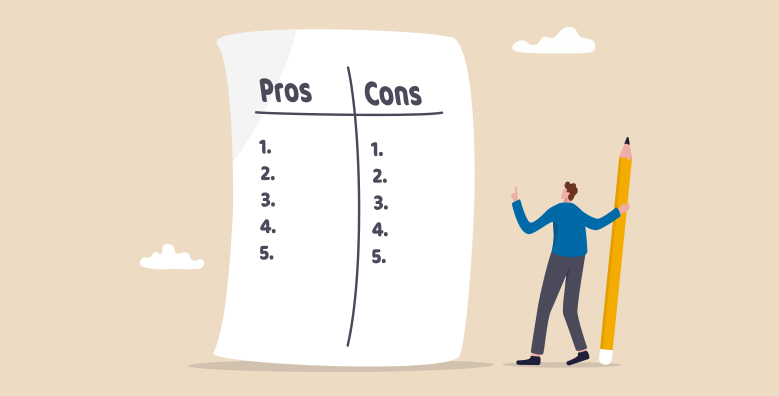
Click the button to start reading
Decision-Making Techniques In Project Management—With Examples!
Productive project management can drive a company towards success, giving employees a clear, easy-to-follow path towards completing their work objectives in a highly efficient manner. If done strategically, project management can keep everyone on track, including upper management, and create much-needed transparency in business processes.
To be able to create realistic goals in line with the company’s vision and still retain flexibility for any unseen circumstances during the project’s life cycle, making effective decisions is crucial to adhere to a structure that keeps the team’s momentum moving forward.
The decision-making process in project management can heavily influence the success employees feel as individuals (and as a team) or, unfortunately, create a litany of workflow issues and interpersonal misunderstandings.

Importance Of Decision-Making In Project Management
There are many reasons why the decision-making process is important to project management:
- Lessens the risk of continued project delays or, in worst cases, delivery of an unfinished assignment
- Takes into account unexpected hurdles and seamlessly keeps the progress of the project going
- Sets up individuals on the team for success in the part of the project they own
- Reduces the amount of overwhelm employees feel by providing achievable deadlines and clarity on relevant processes
- Leverages the various talents on the team so they can operate within their zone of genius and produce high-quality work within the scheduled timeline
- Provides an organized structure that’s easy for everyone to understand and follow
- Helps clarify the goals of the project from start to finish
- Keeps the workflow focused so the team can achieve essential milestones
- Avoids costly mistakes due to repetitive project failures
Strategic decisions in project management are made with these four vital factors in mind:
- The goals of the project – What are the milestones that need to be achieved from the beginning of the project to the very end?
- The resources available – Who on the team will be responsible for particular tasks? What platforms, budget, services, and communication channels are available to the organization, ensuring collaboration and idea-sharing is an easy process?
- The intended outcome – With this project, what do we want to achieve? What does success look like? And what type of value does the organization want to provide?
- The value the result will have on the company overall – How does it impact the organization’s bottom line? Are the goals of the various projects in line with the company’s big-picture mission?
These are key elements of the decision-making process in project management. However, these types of decisions can create challenges for those involved with leading and managing various company initiatives.

Challenges of Decision-Making In Project Management
According to PMI’s “Pulse of the Profession: High Cost of Low Performance,” only 42% of organizations report high alignment with or projects to organizational business strategy. As little as 32% of organizations report that their projects are better aligned than previous years. In other words, if the goals of the project don’t align with the company’s overall strategy, the less success there will be for that organization.
To help overcome some of the inevitable challenges with project management, it’s important to understand the barriers that block efficient decision-making in the workplace:
- Engagement with PM tools – Much of this comes down to how familiar and comfortable employees are with using the company’s chosen systems, allowing for more streamlined project management. Using new technology and adapting to its various updates is a familiar challenge in the workplace. To combat this, training and development should remain a top priority for new and more senior team members to keep their knowledge up-to-date. If a team cannot keep up with evolving technology, they’ll fall behind quickly, unable to properly use these resources to their (and the company’s) benefit. For example, when a new team member is not thoroughly trained in the platforms used to keep track of a project’s progress, this lack of understanding and engagement with the tool can cause disruptive delays. They may not know when to mark a task as complete or how to provide an update so the project manager can make appropriate adjustments to the timeline and notify all relevant parties. This creates an unnecessary, negative domino effect for the entire team.
- Scheduling – Conflicts in scheduling happen frequently, especially if an organization is working on multiple projects at a time. A successful project manager (PM) takes this into consideration when proposing and implementing a timeline that is manageable for everyone. Issues occur when there is a lack of communication about vacation or time-off requests, demands of other projects and how it impacts specific groups, and no organization when it comes time to sync all the relevant calendars together and pull in the necessary resources, enabling a smooth pipeline of simultaneous assignments.
- Rapid changes – Of course, changes occur all the time during the life cycle of any project. External customers or clients can have unique demands, which potentially stray from standard company procedures. Sometimes, the changes to procedures can come from internal management trying to discover new and improved ways of doing different tasks. The PM, in coordination with the project’s key players and leadership, must be able to have thorough conversations about the changes and discover workarounds that benefit everyone involved. It becomes a struggle for the team when project demands are constantly outside of normal practices. This slows down the workflow, causing a backlog of work until a solution can be found. If this happens across multiple projects at the same time, the team may not be able to produce high-quality results. For this type of barrier to be overcome, the team should collectively be upfront about their capacities and what they’re able to accommodate so that the appropriate decisions can be made.
- No existing practices – There are many occasions when a company is in the process of developing new methods and processes in order to find what works best for their team. Since this often takes time and consistent input from all the relevant parties about what’s working and what isn’t, more robust decision-making can be impacted as it can be a trial-and-error process. Those in managerial positions may have different approaches to problem-solving or the process needs to be tested multiple times before the team finds its rhythm.

- Team skills – One of the biggest roadblocks to effective decision-making in project management can be the resources available, including the team’s skill set. The success of a project depends on the people involved with its completion. The team must be able to rely on each other to do their respective parts, with firm checks and balances in place to guarantee a successful outcome and limit mistakes. Managers should be aware of their direct report’s strengths (and provide training for areas needing improvement), assign them tasks that encourage their growth as employees, and understand how the team as a whole works together in order to ensure effective collaboration. This is a crucial part of the decision-making process: making sure that the right people are in the right seats so the project moves forward successfully. Managers should also be able to identify when it’s time to recruit for positions requiring particular skill sets to address any gaps in the current team structure and provide further support.
- Budget constraints – Budgets act as a guide on how to best move forward and can make it clear what projects take priority and what may be consuming too much time without enough return. It can also determine what resources are currently available and what needs to be allocated to other areas of the company. Put simply, budgets can help give a company direction in what’s possible. In order to make good decisions for the short and long term, the leadership team needs to be clear on where it stands financially to ensure productive operations and continued growth and expansion. Another challenge is creating a realistic budget that takes into account all the individual costs that go into a project. A stricter, smaller budget may impede some teams’ ability to get their work done efficiently if not coordinated strategically.
- Communication – In a survey of 400 companies with 100,00 employees, it was revealed that companies lose an average of $62.4 million dollars per year due to poor communication to and between their employees. Companies with poor communication often host a workplace environment where employees find it difficult to stay focused and feel motivated. As project management largely depends on how well a team communicates with one another to get a project to the finish line and problem-solve along the way, any breakdown in communication between leadership and employees can have disastrous results that extend beyond project management.
While many challenges exist that can heavily impact decision-making in project management, there are ways to help facilitate this process that can set the team up for success.

The Decision-Making Process In Project Management
There are a few steps to consider when approaching decision-making in project management:
- Identify the purpose of your decision. This is the essential first step in decision-making. You must be able to clearly define the goal behind the decision needing to be made. For example, let’s say we have a PM who is working on putting together a structure for a writing project that will be read aloud on a podcast. Aside from creating a solid timeline of milestones, the PM will need to have a clear goal in mind in order to make effective decisions. The goal in this specific case would be to identify and choose the few individuals to comprise the team, whose expertise will deliver the final product in a faster manner than usual. Since this particular example is considered a high-priority project needing a finer eye, extra care and diligence must be top of mind when making choosing the appropriate team.
- Have all the information you need directly related to the problem. Before you make a decision, you need to collect all the relevant information, both internally and externally. Let’s take our example of the PM whose team was tasked with writing a project that will be read aloud on a podcast, expanding the company’s visibility. Internally, the PM needs to know the team’s availability to be able to make a decision on a feasible timeline while simultaneously understanding the needs of the external client and their own expectations. This ensures that the team is meeting important milestones.
- Consider the impact it will have on the rest of the team. When it comes to decision-making, you’ll need to keep in mind the proposed decision will have a ripple effect on the rest of the team. If the decision of a PM causes an imbalance of work – with one person getting more work than another – a new decision should be made in order to rectify the situation. Workplace initiatives often require regular feedback from the individuals on a team so that better, well-thought-out decisions can be made. In our example, the PM will need to review the workload of the team against the needs of the project. If there is considerable conflict in schedules or availability, a team discussion may be needed to identify a solution.
- Identify different methods as alternatives. Part of a PM’s job is to think about different workflow paths in the event the process doesn’t go as originally planned, or identify if there is a way to work more effectively given the circumstances of the situation. When considering different alternatives, it’s best to keep in mind that whichever secondary options exist still need to be in line with reaching the ultimate goal of the project. If the alternative option can help the team complete the project faster and more efficiently, this would be the time to evaluate all the information available and make a well-rounded decision.
- Execute your decision. Now that you have all the information you need and have considered the overall impact it will have on the relevant parties, it’s time to execute the decision. The team will carry it out as discussed with relevant check-ins during the process, especially if it is new to the organization. This ensures the workflow process is running smoothly and gives an opportunity to identify, solve, and discuss any issues that arise needing the team’s input.
- Evaluate continuously. As with any other decisions that impact the team and the work product, evaluation is necessary to help keep processes fresh and effective. You must consider the results of your decisions and whether or not it has met the needs of the project. If not, additional information may be needed in order to make better, more informed decisions when reviewing and improving the processes in the future.
Now that we understand the initial stages of decision-making, let’s talk about the different techniques you can apply in the workplace.

Examples Of Decision-Making In Project Management
Effective decision-making techniques are a healthy combination of intuition, experience, and analysis. Let’s take a look at examples of decision-making in project management.
- Heuristic Technique – This is a method of problem-solving when you want to make quick decisions given a limited time frame, accelerated deadline, or have complex data. This involves relying on past experience, recalling similar situations, intuitive guesswork, trial and error, and mental shortcuts to arrive at a fast solution. This method is intended to be flexible, leaving room for future adjustments. The one downside to this approach is that it can produce errors later in the project’s life cycle. If a particular project is similar in scope and circumstances to a previous assignment, the team can use estimations based on this prior data to make decisions.
- Multi-voting – Multi-voting is a group decision-making technique structured to reduce a large number of action items to a manageable amount based on a team discussion and subsequent vote. The result is a prioritized list that identifies what is most important to the team. Often used during brainstorming sessions, each team member selects from a large number of items what they feel is the most important in the bunch. Depending on the group, this can be done electronically, physically (via a ballot), or through raised hands in a meeting. Each person casts one vote. Then the votes are tallied and the process is repeated until there is a prioritized list of top items. In the case of project management, multi-voting can manifest when the PM works with leadership on an upcoming project. After some discussion about the assignment and the potential issues that may be relevant, the group can then come up with an organized list of the high-priority action items needing to be done.

- Pros/Cons – Quantifying the pros and cons of a decision is one of the most standard approaches. This simple method allows you to think about your decision from all perspectives before confidently making a choice. It’s a quick, easy method to implement that results in objective decisions. This is especially useful when you have doubts about the decision you’re about to make. Whether you decide to do this electronically or on a piece of paper, you can start by writing down your decision at the top. Then, using two columns, write down all the benefits your decision will have on the team. In the other column, you can then jot down your thoughts on any negative outcomes you potentially foresee. An effective way to fully utilize this approach is to get your initial thoughts down as quickly as you can. After you have something on paper, you can then consider the more thoughtful additions to either column. The limitation to this technique is that this is best used when offered up two concrete choices and doesn’t offer much flexibility when you’re faced with multiple issues. Project management often involves various amounts of problem-solving, so if a quick decision needs to be made that has been thoroughly vetted, then evaluating the pros and cons of a decision can prove useful.
- Decision-Tree Analysis – Decision-tree analysis is a visual representation of decisions, potential outcomes, consequences, and possible costs. Using a series of branches and nodes, this support tool can help the project management team identify solutions and evaluate their readiness for implementation. Conversely, branches holding alternative options can be cut entirely from the diagram based on their usefulness to the project. This method is most useful for complex problem-solving, operations, strategies, and cost management. Undeniably, the greatest advantage of the technique is that it is a visual tool, allowing you to see all the possible scenarios in combination with expected outcomes. To use this method in project management, you first need to define the problem in which a decision is needed. Then you can start drawing the decision tree with all the possible solutions and consequences. Anything relevant to the outcome goes into the tree. This includes the monetary value and potential payoffs.

- SWOT analysis – SWOT stands for Strengths, Weaknesses, Opportunities, and Threats. It can reveal areas that need improvement and what is likely to succeed. In project management, Strengths will be your internal factors such as the resources you have available like software, the expertise of the team members, customer relationship, etc. Weaknesses, on the other hand, are the factors that hinder the project’s completion such as budget constraints, an inexperienced team, or lack of transparency into established processes. Opportunities are the external factors that support the project such as another task finishing early, freeing up more resources for the team. Threats are what can impair the success of the project. When you understand how all these components work together, it’s easier to come up with a strategic decision so you can take appropriate action.
In Conclusion
Decision-making in project management can be a painstaking process. So much of the success of a project depends on the types of decisions made within the team.
It’s critical to understand the examples of decision-making in project management and how they can support you in making the best, most informed choices for your team and organization.
















